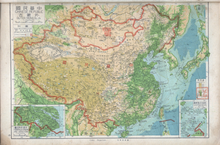Postal Map Romanization
| Chinese postal romanization | |||||||||

A map of China with romanizations published in 1947.
|
|||||||||
| Chinese | 郵政式拼音 | ||||||||
|---|---|---|---|---|---|---|---|---|---|
| Literal meaning | Postal-style romanization system | ||||||||
|
|||||||||
| Transcriptions | |
|---|---|
| Standard Mandarin | |
| Hanyu Pinyin | Yóuzhèngshì Pīnyīn |
| Wade–Giles | Yu-cheng-shih P'in-yin |
Postal romanization was a system of transliterating Chinese place names developed by the Imperial Post Office in the early 1900s. The system was in common use until the 1980s.
For major cities and other places that already had widely accepted European names, traditional spellings were retained. With regard to other place names, the post office revised policy several times. Spellings given could reflect the local pronunciation, Nanjing pronunciation, or Beijing pronunciation. Although pronunciation-based arguments were made for each option, using postal romanization to determine any form of Chinese pronunciation was limited by the fact that the system dropped all dashes, diacritics, and apostrophes, to facilitate telegraphic transmission.
At a conference held in 1906 in Shanghai, the post office selected a system of romanization developed by Herbert Giles called "Nanking syllabary." Although Beijing dialect had served as a national standard since the mid-19th century, the system adopted was based on Nanjing pronunciation. The system corresponded to various traditional romanizations that were adopted in the 18th century when Nanjing dialect was considered standard. French-appointed administrators ran the post office at this time, and they sought a less anglicized alternative to Wade-Giles.
An imperial edict issued in 1896 renamed the Maritime Customs Post, reorganized this agency as a national postal service, and established the Imperial Post Office. In 1899, Robert Hart, as inspector general of posts, asked postmasters to submit romanizations for their districts.
Although Hart asked for transliterations "according to the local pronunciation," most postmasters were reluctant to play lexicographer and simply looked up the relevant characters in a dictionary. The spellings that they submitted generally followed a system created by Thomas Francis Wade, now called the Wade-Giles system. The system had been developed in 1859 and was based on the Beijing pronunciation. It became the standard method of romanizing Chinese after Herbert Giles published a dictionary, using the system, in 1892.
The post office published a draft romanization map in 1903.
Disappointed with the Wade-based map, Hart made another attempt to promote localism in 1905. He directed the postmasters to submit romanizations "not as directed by Wade, but according to accepted or usual local spellings." Local missionaries could be consulted, Hart suggested. However, Wade's system reflected pronunciation in most areas served by the post office, at least in Mandarin-speaking areas.
...
Wikipedia
